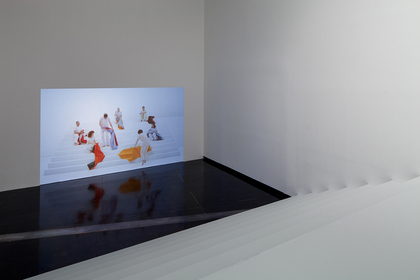-
From Current Issue
-
- Editor’s Letter Fire in the Heart
- Reviews I Gusti Ayu Kadek Murniasih
- Reviews 11th Seoul Mediacity Biennale: “One Escape at a Time”
- Dispatch Networked China
- One on One Monira Al Qadiri on Yukio Mishima
- Essays The rise of independent art spaces in pandemic-era Shanghai
- Features Tuan Andrew Nguyen
- Table of Contents
- Web Exclusives
- Archive
- Subscribe

R
E
V N
E
X
T
ULLA VON BRANDENBURG, Eigenschatten I–VI (Own Shadow I–VI), 2013 mixed media, dimensions variable. Installation view of “It Has a Golden Yellow Sun and an Elderly Grey Moon,” at Australian Centre for Contemporary Art (ACCA), Melbourne, 2016. Photo by Andrew Curtis. Courtesy ACCA.
Visitors to Melbourne’s Australian Centre for Contemporary Art (ACCA) in the past two months have been greeted with an exhibition that could somewhat be described as a deconstructed theater play. Stage props, dramatic choir soundtracks and family-drama scenes, a forest backdrop and stage curtain are just some of the elements that make up German artist Ulla von Brandenburg’s current exhibition, “It Has a Golden Yellow Sun and an Elderly Grey Moon.” Her first solo show in the Australasian region presents an in-depth look at the artist’s ongoing interest in theater, storytelling, psychoanalysis and color theory.
A large orange stage curtain formally marks the entrance into von Brandenburg’s world where everything teeters on the edge of illusion and reality. Moving through the curtain drapes, viewers are greeted with the installation Eigenschatten I–VI (Own Shadow I–VI) (2013), where stage props that the artist collected from flea markets during a six-month stay in Rome are suspended from the ceiling with string. Objects such as a chair and a hat hang above the viewer’s head like that of a child’s mobile. The objects and their practical functions are removed from reality—not only for being displayed within a gallery, but also by the dislocation of their shadow. Leaning against the wall in a straight line are matching silhouettes of each object on large pieces of fabric, which the artist transferred using a photo-bleaching technique. If shadows can be thought of as markers that situate our bodies in a certain time and place, or as a tool for measuring the passing of time, then the suspended stage objects seem to occupy a surreal and multi-dimensional world where time is redefined. Here, the stage props appear as talismans with magical qualities, where their presence, rather than simply serving to provide context, are themselves the focal point.
Drawing on 19th-century shadow theater, von Brandenburg’s film Shadowplay (2012) show silhouettes of actors who are performing with small puppets modeled after their own appearances. The cast lip-syncs to an unseen choir who sing lyrics describing the roles of the actor. Through puppetry they are able, in part, to control their identity, which is a reflection on the perfect self-representation we seek to uphold in society. Their silhouettes almost match the scale of a real human body, making for an eerie feeling that the invisible actors are perhaps also somewhere in the room.
In von Brandenburg’s film Choral Play (2010), the camera moves between different generations of a family, creating a collage of perspectives on screen. A painted white square on a clearing in the forest is where the domestic scene plays out. A somber chorus of voices perform a song written by von Brandenburg herself, which the actors lip sync. Von Brandenburg’s interest in how lives converge and relationships evolve is paralleled in the constant shifting perspective of the camera and the soundtrack of multiple voices. Her lyrics are often written in German in a stream-of-consciousness style, which results in a jumbled collection of words that, when translated, adds a confusing yet mysterious air of riddle to the play.
The artist’s background in stage design is also evident in the exhibition. Forest (2011) encases the viewer in an almost 360-degree black-and-white painting of trees. Appearing slightly out of focus, the globular forms of tree trunks circle back from one side to other, as if intended to be a psychological ink blot test for the analysis of one’s perception.
Moving along from the fairytale-like encasing of Forest, viewers reach a set of white stairs that act as a bridge to the new 16mm film It Has a Golden Yellow Sun and an Elderly Grey Moon (2016). The work, co-commissioned by four art institutions across the globe, is one of von Brandenburg’s only films shot in color. It features the same stairs upon which the viewers walk over, but with squares of colored fabric draped over them and a number of dancers positioned on different steps. As the dancers move—either by performing modern dance choreography, sit idly, or simply contemplate the colored cloths by folding and unfolding them—a kind of transaction takes place. This air of unknown ritual is further mystified by the lack of dialogue. The bright popping colors stand out against the stark whiteness of the costumes and settings, making the hues the primary yet abstract, focal point.
Von Brandenburg’s exhibition at ACCA both reveals the mechanics behind theater, but also upholds its magical illusions at the same time. Viewers are given a compelling look into the artist’s practice that explores various modes of storytelling through theater, film and voice.
Ulla von Brandenburg’s “It Has a Golden Yellow Sun and an Elderly Grey Moon” is on view at Australian Centre for Contemporary Art, Melbourne, until July 17, 2016.





